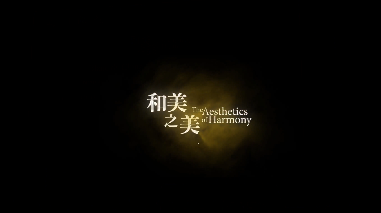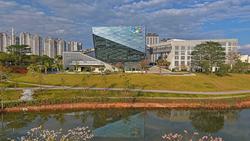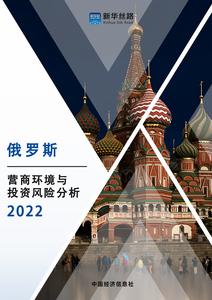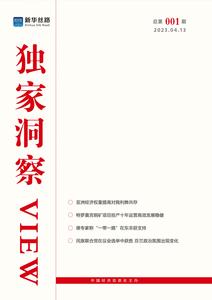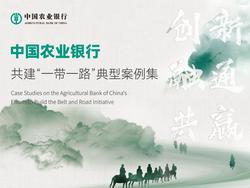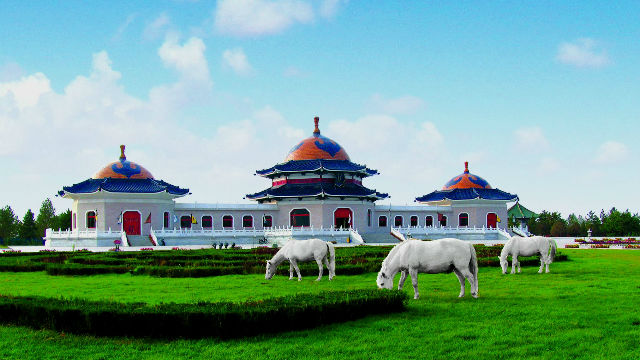
While Ordos exhibits a fresh and vibrant demeanor through its expansive landscapes, Genghis Khan’s mausoleum is rather solemn and magnanimous.
As one visits Ejin Horo Banner to pay homage to great Khan in mid-summer, his mausoleum greets one with green pines and cypresses ardently guarding the perimeter of their master’s abode.
Memorials for Genghis Khan have been pouring in for nearly 800 years. The scale of these memorials, the time span and number of devotees for Khan is unparalleled if compared with past emperors. On March 21, 2015 per lunar calendar, in the Chagansuluke Spring Fete, there were 120,000 people from all ethnic groups gathered at Genghis Khan’s Mausoleum, setting a record for the largest number in a one-day memorial. Memorials for Genghis Khan are enduring, which shows the great influence of Genghis Khan’s spirit and reflects the masses’ admiration. Day Fete, Monthly Fete, and Seasonal Fete and so on … Every fete is reflective of Genghis Khan’s achievements and sacred Mongolian traditions which embody their devotion of several generations and their growth across times. Genghis Khan’s Mausoleum is a great treasure in Mongolian culture, an immortal monument of national history and a glorious palace with national spirit.
As one enters the main hall of the mausoleum, one is embraced by a magnificent era in history. As many as 800 years ago, Genghis Khan swept across Europe and Asia and created the largest country in human history with two-third of the world’s civilized region. The Mausoleum of Genghis Khan Scenic Area spread over 80 square kilometers, displays this heroic style of Genghis Khan. In main hall stands a white marble statue of Genghis Khan; vivid and dignified, while a vast territory map of the Mongolian Empire lies behind it. Taking a closer look at the golden saddle and long bow in “Babai Room” and then imagining Khan whipping his horse and forging ahead is an exciting experience. No matter how broad your mind is or how far your warhorse can run, Genghis Khan’s dictums are still encouraging us to take a broader mind and advance bravely.
The coffins of Genghis Khan and his queens are placed in the rear hall. The butter lamps still light the hall as devotees flock to the mausoleum. According to the historical record, Genghis Khan was buried in a place that was six days away from his birthplace in Kente Mount in Mobei. Ordos’s elite troops accepted the task of protecting Genghis Khan’s Mausoleum. When “Babai Room” was settled in Hetao, Ordos’s troops were guarding them, so the lands inside the yellow river bends became to be known as “Ordos”.
Ordos and Genghis Khan shared a connection from the very beginning and relied on each other. It is a sacred history. What co-exists with real history is a legend that when Genghis Khan passed by Ordos, he was so awestruck by its beauty that his horsewhip fell from his hands. He praised Ordos as a place where golden-horn deer rested, a paradise were Daisheng birds’ fed their children, a place where a declining empire could prosper and a state where the old lived happily. He asked his men to bury him here after his death. Today, these legends are as dignified as an epic, matching with the sacred history. The most substantial essence of the Genghis Khan fete is that it showed a reality that Mongolian admiration and sincere support for Genghis Khan. To expand history and succeed culture by fetes is an innovation in world civilization and also great achievements by Mongolian.
Historically, Genghis Khan’s mausoleum has been moved for several times. After Ordos Troops settled in Hetao, they served Genghis Khan’s mausoleum in Wangaizhao. In the 6th year of Sunzhi (1649 AD) in Qing Dynasty, Elinchen, the first leader in Yikezhao moved Babai Room to Bayan Chang Hogg Grassland. After that, this place was called Ejin Horo In 1939. In order to avoid Japanese invasion in Ordos, Genghis Khan’s Mausoleum was moved to Xinglong Mountain, Yuzhong County, Gansu Province. When it went by Xi’an, the government in Shaanxi-Gansu-Ningxia Border Region held a grand ceremony and Mao Zedong and other Chinese leaders presented their own wreaths. In 1949, Genghis Khan’s mausoleum was then moved to Ta’er Temple in Qinghai. Under the new China, Genghis Khan’s Mausoleum returned to Ejin Horo in 1954. Mongolian and Han cheered and greeted as tens of thousands of people worshiped him along the way. During the westward migration of Genghis Khan’s Mausoleum, the Darkhad people had been following, guarding and serving it. One may run into Jin Bao in the main hall of Genghis Khan’s Mausoleum, who is the 40th generation guardian, and his grandfather was one of the Darkhads who guarded the migration. 30-year-old Jin Bao has been serving here for 12 years. It is a sacred job for him. JinBao says, “Our ancestors stick to this duty although the conditions were difficult. We have to guard the holy redeemer’s mausoleum.” Jin Bao loves photography and shot a lot of beautiful sceneries in Chengjisihan’s Mausoleum before releasing them on WeChat. The new generation of Darkhads has remained loyal to guarding Genghis Khan’s Mausoleum, although they promote it in a new way and record its development.
Genghis Khan’s Mausoleum is not only a national-level key cultural relics protection unit but also a national AAAAA-class tourist attraction and base for cultural demonstration. It organically integrates inherited legacy and modern development. The management committee of Genghis Khan’s Mausoleum Tourism Area in Ordos continues to strengthen its management. It introduced East Union Group to participate in the construction of tourist attractions. The management committee is equipped with a dedicated sacrificial culture office, all of whom are descendants of the Darkhad.
Relying on Genghis Khan’s Mausoleum, Ejin Horo Town is developing its tourism industry. It is being shaped into a world-class cultural tourism town. Herdsmen around Genghis Khan’s Mausoleum area are mostly engaged in tourism-related industries. At every great fete, management committee and town government organize the corresponding cultural tourism activities, so that the relevant cultural activities in Genghis Khan fete become richer.
This summer, in the Nao’er great fete, the committee of Genghis Khan’s Mausoleum tourism area held Genghis Khan Horse Culture Festival. “This year, there are the most people, and it is too busy to sell 50 Yuan a bowl of haricot.” Alatengwula, a herdsman in Bulagegacha can earn 10,000 Yuan a day during the Cultural Festival. On the country road in Bulagegacha, one may run into Batujiga, who sells yogurt in his car. He can sell 3-4 barrels of yogurt every day on the roadside and his earning is considerably good. The businesses at ethnic handicraft shops and “Herdsmen Home” are pretty good as well. Perhaps this is the blessing of God. Every fete, the surrounding herdsmen set out for Genghis Khan’s memorials as a whole family. Speaking of participation in fetes, Dalengtai, a herdsman in Bulagegecha only say out three words, “We have to go.” Their devotion to Genghis Khan is unshakable.
Ordos Troops live their lives as guardians of Genghis Khan’s Mausoleum. Their spirit has inspired Ordos’s people for long. The efforts for reform and development of Ordos prove that Ordos people have faithfully inherited and expanded the nationalistic spirit of Genghis Khan for creating a brilliant civilization. There is a need to project the outstanding qualities of Ordos, such as open-mindedness, tolerance, honesty, friendliness, perseverance, hard work and innovation. This aptly summarizes Ordos people’s character which they have inherited from Genghis Khan. Let’s spread the outstanding spirit of Ordos and continue to forge ahead!
Towering Genghis Khan’s Mausoleum and national spirit is succeeded for generations.
Ordos, struggling and innovating!



